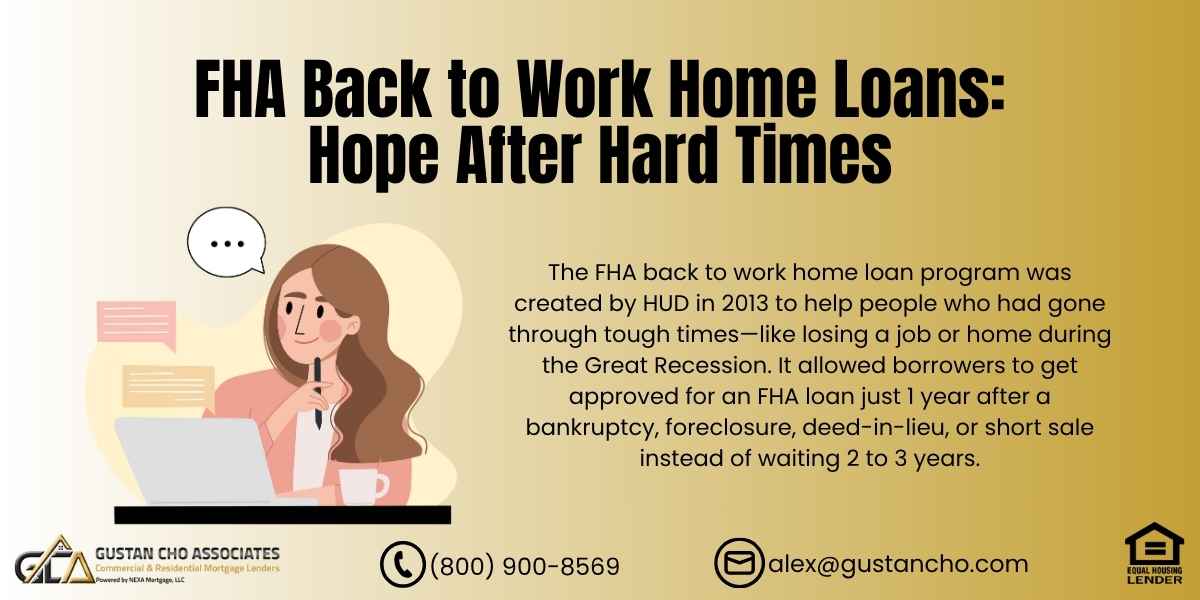FHA Back to Work Home Loans: 2025 Guide to Buying After Hardship
If you lost your job, went through a foreclosure, or filed for bankruptcy in the past, and you’re wondering if homeownership is still within reach, you’re not alone. Many families are looking for ways to bounce back after financial hardship. That’s where the term “FHA Back to Work home loans“ comes in. But what is it really? Is the program still active in 2025? And how can you qualify for a mortgage today?
Let’s simplify everything and help you get back on the path to homeownership with Gustan Cho Associates, a mortgage lender known for helping borrowers who were turned down elsewhere.
What Were FHA Back to Work Home Loans?
The FHA back to work home loan program was created by HUD in 2013 to help people who had gone through tough times—like losing a job or home during the Great Recession. It allowed borrowers to get approved for an FHA loan just 1 year after a bankruptcy, foreclosure, deed-in-lieu, or short sale instead of waiting 2 to 3 years.
But there were strict rules:
- The job loss had to be involuntary (no quitting).
- You needed to prove a 20% or more drop in household income.
- You had to be unemployed for at least 6 months.
- You needed to show good credit before the hardship, and no late payments since recovering.
You also had to take a HUD-approved housing counseling course 30 days before applying.
Ready to Rebuild Your Path to Homeownership?
Contact us today to explore your eligibility and take the first step toward securing your new home.
Is FHA Back to Work Still Available in 2025?
No. The official FHA Back to Work program ended several years ago and is no longer active. However, the good news is that you can still qualify for FHA loans after hardship through different options.
At Gustan Cho Associates, we work with borrowers in bankruptcy, foreclosures, or other financial setbacks. We offer manual underwriting, non-QM loans, and FHA loans with flexible guidelines that can help you qualify, even if you were recently denied by another lender.
Let’s explore your current options.
FHA Loan Waiting Periods After Hardship (2025)
Even though FHA Back to Work home loans are no longer active, you may still be able to qualify under standard FHA guidelines:
- Chapter 7 Bankruptcy: 2-year wait from discharge
- Chapter 13 Bankruptcy: No wait after discharge; 12 months of on-time payments required if still in repayment
- Foreclosure or Deed-in-Lieu: 3-year wait from recorded date
- Short Sale: 3-year wait
If you face tough situations like losing your job, a medical emergency, or a family death, those timeframes could be shorter. Just remember you’ll need some paperwork and a solid story about how you’re bouncing back. That’s where manual underwriting steps in.
What Is Manual Underwriting?
If you don’t meet the automated system’s requirements, a real person can manually underwrite your file. This allows lenders to examine your whole story, not just your credit score.
Manual underwriting is available on FHA loans and is often used for borrowers recovering from hardship.
To get approved under manual underwriting, you typically need:
- Perfect payment history for the last 12 months
- Verification of rent (12 months of canceled checks or bank statements)
- Stable income and employment
- Low debt-to-income ratio (DTI), usually under 43%, but up to 56.9% with compensating factors
Common compensating factors include:
- Larger down payment
- Savings/reserves in the bank
- Long-term job history
- No new credit issues since hardship
FHA back to work home loans used to require manual underwriting, and that option is still available today.
What If I Don’t Meet FHA Guidelines Yet?
If you’re still within a waiting period or can’t meet FHA guidelines, don’t worry. Here are other mortgage options that may help:
1. Non-QM Loans
Non-QM loans, or non-qualified mortgages, are special loans for people who don’t fit the usual rules for getting a mortgage. You might still be able to get one of these loans if you faced a recent foreclosure or bankruptcy. You could qualify even if you are self-employed and only have bank statements to show your income. These loans can also be helpful if you need an interest-only loan or a loan based on your assets.
2. DSCR Loans (For Investors)
If you want to buy a rental property, consider looking at a special loan called a Debt Service Coverage Ratio (DSCR) loan. This type of loan differs from regular loans because it lets you qualify based on the money you make from renting out the property instead of looking at your personal income or credit score. This means if your rental income is enough to cover the costs of the loan, you could get the loan even if your personal finances aren’t perfect. It’s a great option for investors who want to start or grow their rental property business!
3. Portfolio Loans
These are loans offered by private lenders who keep the loan in-house. They offer more flexible rules and may approve you sooner than FHA or conventional lenders.
At Gustan Cho Associates, we specialize in all of these.
Overcome Past Financial Challenges with the FHA Back to Work Program
Reach out now to understand the requirements and see how you can qualify for this opportunity.
Rebuilding After Hardship: What Lenders Look For in 2025
Whether you’re applying for a regular FHA loan or something more flexible, here’s what lenders want to see:
- Proof that the hardship is behind you
- Stable income and job history (at least 6–12 months)
- No recent late payments or new collections
- Re-established credit (secured cards, car loans, etc.)
If you don’t have regular credit, you can use other types of credit to help you. For example, you can show that you have been paying your rent, utility, cell phone, and car insurance on time. It’s really important to prove that you’ve paid these bills on time for at least 12 months. This proof helps when someone is checking your credit in a process called manual underwriting.
Can You Still Buy a Home After Bankruptcy or Foreclosure?
Yes, you can. Even though FHA Back to Work home loans are no longer around, thousands of people still buy homes each year after filing bankruptcy, losing a home, or going through a tough time.
You need the right lender who understands how to tell your story—and how to work around the typical roadblocks.
At Gustan Cho Associates, we don’t have lender overlays. We follow FHA’s minimum guidelines and offer flexible solutions for borrowers with past credit issues.
Real Stories. Real Approvals.
We’ve helped:
- A teacher bought a home just 13 months after Chapter 7 bankruptcy with a strong manual underwrite
- A self-employed business owner qualified for a bank statement loan just one year after closing their prior company.
- A couple who lost their home during COVID bought a new one after rebuilding their credit with secured cards and a rental history
Let us help you, too.
Final Thoughts: FHA Back to Work Home Loans May Be Gone, But Help Is Still Here
The original FHA Back to Work home loans program was helpful for many, but it’s no longer available. That doesn’t mean your dreams of homeownership are over.
In 2025, there are more loan options than ever before for people rebuilding after hardship:
- FHA loans with manual underwriting
- Non-QM and portfolio loans
- Bank statement and no-doc loans
Whether you had a bankruptcy, job loss, or foreclosure, you can still buy a home.
Let’s Talk About Your Options Today
At Gustan Cho Associates, we focus on assisting individuals in obtaining approvals when other lenders decline their applications. We excel in manual underwriting, non-QM loans, and tailored loan solutions.
Let’s rebuild your path to homeownership—starting now. Borrowers who need a five-star national mortgage company licensed in 52 states with no overlays and who are experts on FHA back to work home loans, please contact us at 800-900-8569, text us for a faster response, or email us at alex@gustancho.com.
Frequently Asked Questions About FHA Back to Work Home Loans:
Q: What are FHA Back to Work Home Loans?
A: FHA back to work home loans were a special mortgage program that helped people buy a home just one year after going through tough times like job loss, bankruptcy, or foreclosure. The program ended, but there are still ways to qualify for a home loan today.
Q: Is the FHA Back to Work Home Loan Program Still Available in 2025?
A: The official FHA back to work home loans program is no longer active. But you can still get an FHA loan after hardship using manual underwriting or other flexible loan options.
Q: How Long do I Wait After Bankruptcy to Get an FHA Loan?
A: If you file for Chapter 7 bankruptcy, you must wait two years after discharge. For Chapter 13, you can get approved right after your discharge or even during the repayment period if you have made 12 months of on-time payments.
Q: Can I Still Get a Loan if I had a Foreclosure or Short Sale?
A: Yes. FHA loans usually require a 3-year wait after a foreclosure or short sale, but shorter waiting periods are possible with strong paperwork and manual underwriting—just like FHA back to work home loans used to offer.
Q: What is Manual Underwriting, and How Does it Help?
A: Manual underwriting is when a real person (not a computer) reviews your loan file. If your credit isn’t perfect but you’ve been on time with bills and have steady income, manual underwriting can help you get approved, just like how FHA back to work home loans worked.
Q: What do Lenders Look for if I’ve had Financial Hardship?
A: They want to see that your hardship is over, you have a steady job and income, and you’ve paid your bills on time for the last 12 months. These are key things for getting approved, especially under manual underwriting or FHA back to work home loans alternatives.
Q: What if I Don’t Meet FHA Loan Rules?
A: No worries! If you’re self-employed, you may qualify for non-QM loans, portfolio loans, or even bank statement loans. These flexible options are great alternatives to FHA back to work home loans.
Q: Can I Use Rent and Utility Bills as Proof of Credit?
A: Absolutely! If you lack credit cards or loans, you can demonstrate 12 months of timely payments for rent, utilities, phone bills, or car insurance to aid in qualifying—similar to how individuals did with FHA back to work home loans.
Q: Can I Still Buy a Home After Losing My Job Last Year?
A: Yes. You may still qualify if you’ve been back to work for at least 6 to 12 months, and your income is stable. FHA back to work home loans were made for situations like this, and today’s loans can still help you recover.
Q: Who Can Help Me Qualify if I was Turned Down Before?
A: Gustan Cho Associates specializes in helping people get approved, even after hardship or being denied. We know the guidelines, offer no overlays, and are experts on FHA back to work home loans and today’s alternative mortgage options.
This blog about “FHA Back to Work Loans: Hope After Hard Times” was updated on May 12th, 2025.
Looking to Buy a Home After Bankruptcy? Find Out When You Can Qualify for an FHA Loan!
Reach out now to understand the requirements and see how you can qualify for this opportunity.




